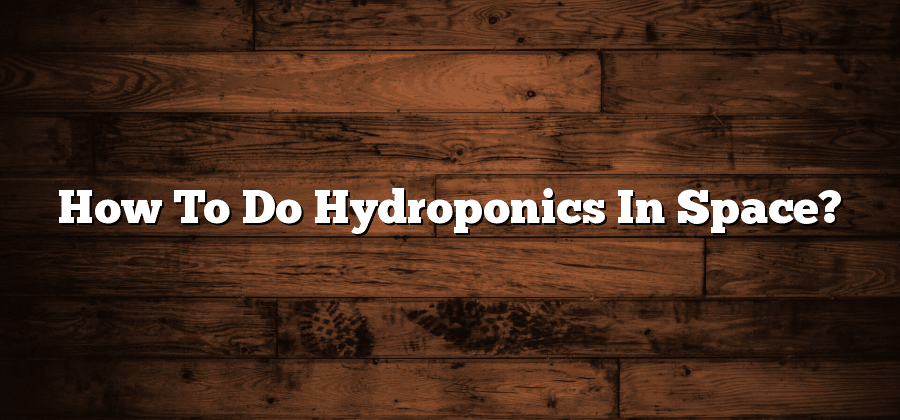Benefits of Hydroponics in Space
Hydroponics offers numerous benefits for cultivating plants in the confined environment of space. One major advantage is the conservation of resources. Unlike traditional soil-based agriculture, hydroponics uses a fraction of the water and nutrients. Water is scarce on spacecraft, and the recycling capabilities of hydroponic systems ensure efficient use of this valuable resource.
Another benefit is the increased growth rate of plants in a hydroponic system. In space, where resources are limited, it is crucial to maximize the productivity of crops. Hydroponics provides an optimal growth environment with precise control over essential factors such as temperature, light intensity, and nutrient concentration. As a result, plants can grow faster, allowing for a higher yield in a shorter time frame. The accelerated growth also means that fresh food can be harvested more frequently, ensuring a continuous supply of nutritious meals for astronauts during long-duration missions.
Understanding the Challenges of Growing Plants in Space
When it comes to growing plants in space, there are several unique challenges that must be overcome. One of the primary obstacles is the lack of gravity, which can impact how plants absorb water and nutrients. Without gravity, plants have difficulty establishing a root system and distributing water and nutrients effectively. Additionally, the absence of gravity can cause plants to grow in unpredictable directions, making it difficult to maintain a structured and orderly growth pattern.
Another challenge of growing plants in space is the limited availability of resources. Spacecrafts often have limited space, making it crucial to maximize efficiency and productivity. This means that every aspect of the cultivation process must be carefully planned and optimized to minimize waste and resource consumption. Additionally, the availability of water and nutrients is limited, requiring innovative solutions to ensure plants receive the necessary elements for growth.
Overall, understanding and addressing these challenges is essential for successful plant cultivation in space. By developing strategies to overcome the lack of gravity and optimizing resource utilization, scientists and astronauts can pave the way for sustainable food production during long-duration space missions.
Essential Equipment for Space Hydroponics
Space hydroponics is a challenging endeavor that requires specialized equipment to create a conducive environment for plant growth. One essential piece of equipment is the hydroponic system itself. These systems are designed to provide the necessary nutrients and water directly to the plant’s roots, eliminating the need for soil. In the confined space of a spacecraft, hydroponic systems are compact and designed for efficient use of resources.
Another vital piece of equipment for space hydroponics is a lighting system. Since natural sunlight is not readily available in the depths of space, artificial lighting is crucial to enable plants to undergo photosynthesis. LED lights are commonly used for this purpose, as they emit the specific wavelengths of light that plants require for optimal growth. Additionally, these lights are energy-efficient and generate less heat, which is essential in the limited space and controlled environment of a spacecraft. By providing the right amount and quality of light, the plants can thrive and produce the necessary oxygen and food for the astronauts onboard.
Selecting the Right Plants for Space Hydroponics
Plants play a crucial role in supporting life on Earth, and they can also offer numerous benefits for astronauts in space. However, not all plants are suitable for hydroponic cultivation in the unique conditions of space. When selecting plants for space hydroponics, several factors need to be considered.
Firstly, it is important to choose plants that are able to thrive in a microgravity environment. Some plants, like lettuce and radishes, have been successfully grown in space due to their ability to adapt to reduced gravity. These plants have shallow root systems, which makes them ideal for hydroponic cultivation. Additionally, fast-growing plants are preferred, as they can provide a quicker harvest and reduce the time and resources needed for cultivation.
Nutrient Solutions for Optimal Plant Growth in Space
In the challenging environment of space, providing plants with the necessary nutrients is crucial for their optimal growth and development. Nutrient solutions play a vital role in supplying plants with the essential elements they need for photosynthesis and overall health. These solutions, which are typically a mix of water and various nutrients, are carefully formulated to meet the specific needs of plants in space hydroponics systems.
One key consideration when creating nutrient solutions for space hydroponics is ensuring that they are easily accessible to plants. In microgravity conditions, where water can behave differently than on Earth, it is important to design systems that facilitate nutrient uptake by the roots. Additionally, the nutrient solutions used in space must be well-balanced, containing the appropriate ratios of macronutrients (such as nitrogen, phosphorus, and potassium) and micronutrients (such as iron and magnesium) to support healthy growth. Achieving this balance is essential for avoiding deficiencies or toxicities that could negatively affect plant growth.
By carefully selecting and formulating nutrient solutions for space hydroponics, scientists and astronauts can provide plants with the ideal conditions for thriving in the unique environment of space. The ongoing research and development in this field are instrumental in furthering our understanding of how to sustainably grow plants in space, providing not only food but also psychological benefits for future long-duration missions.






